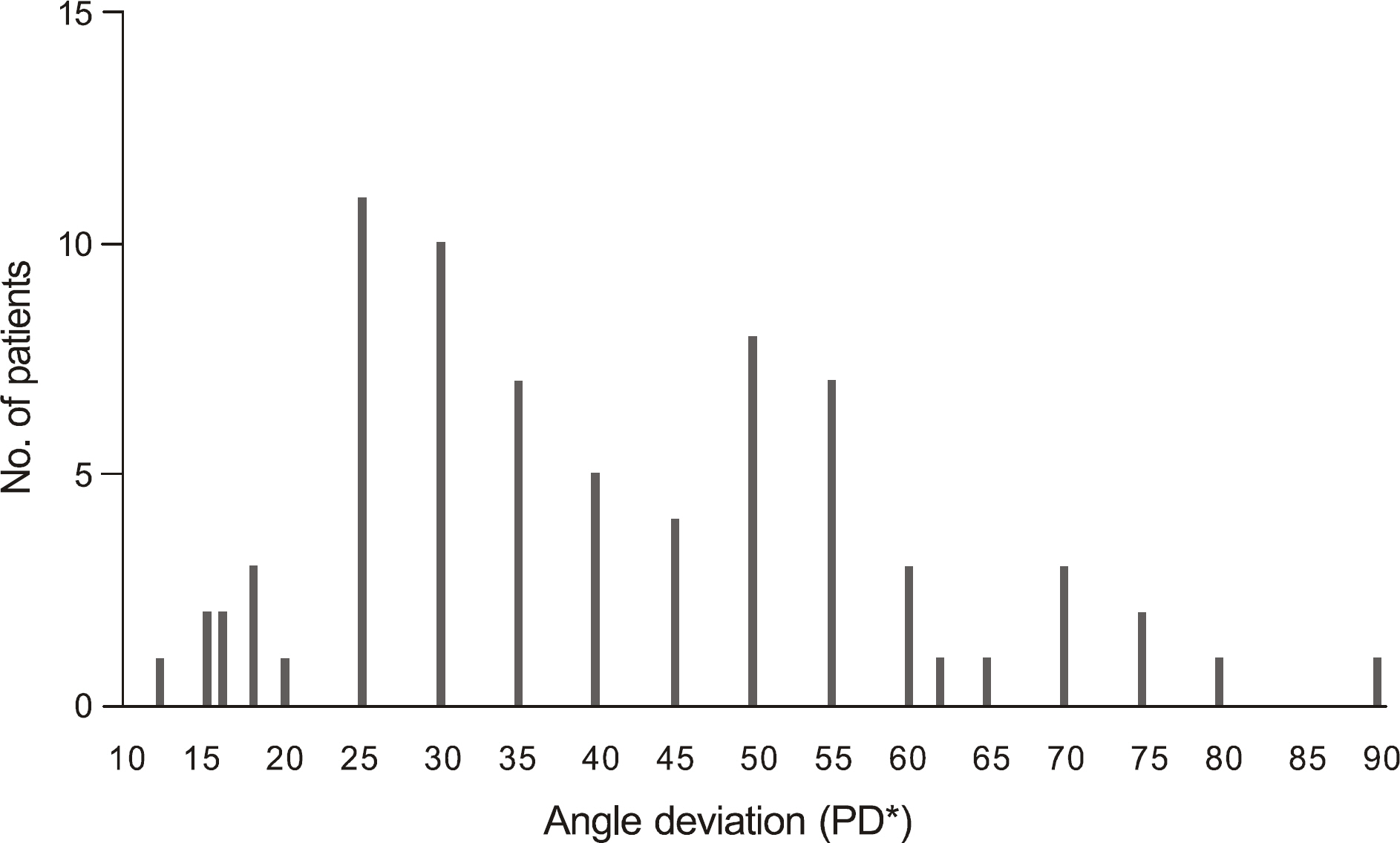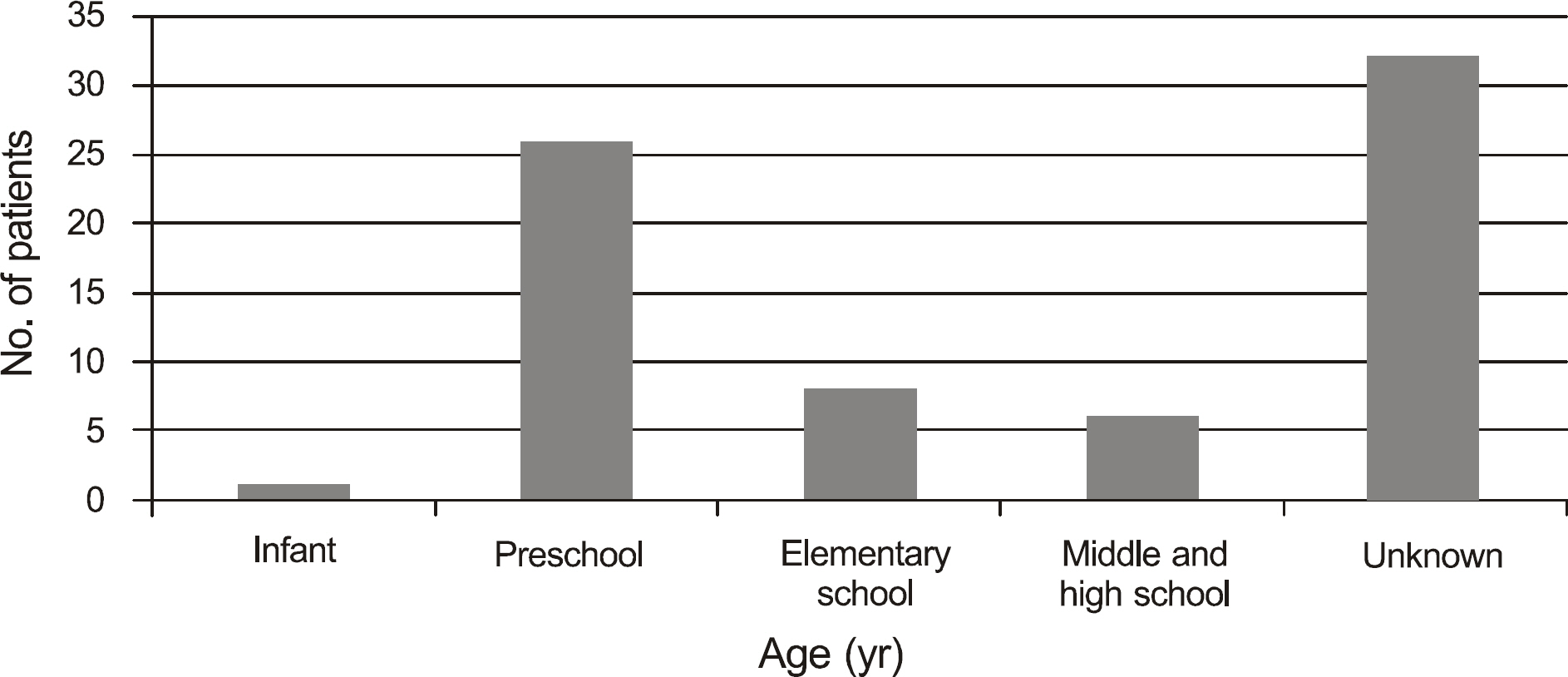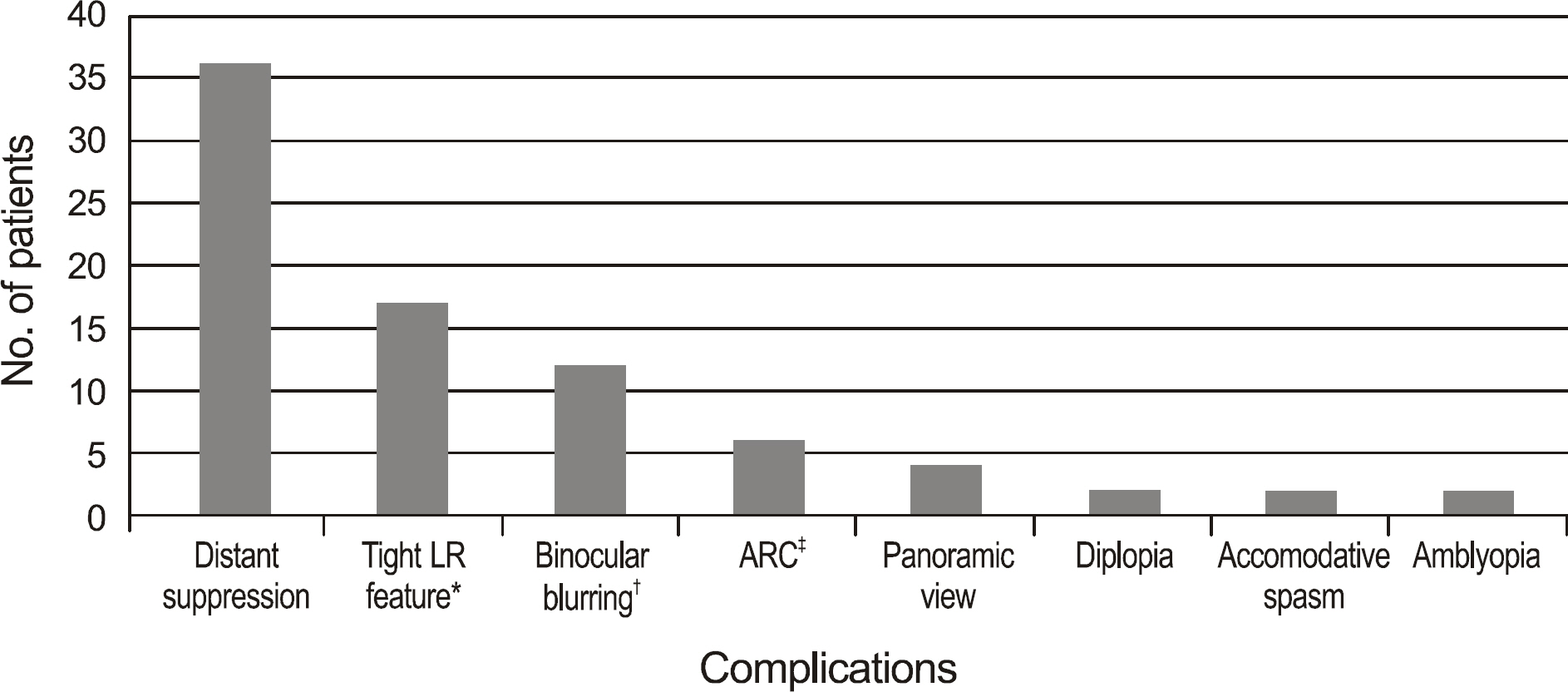J Korean Ophthalmol Soc.
2011 Sep;52(9):1077-1082.
Long-Standing Intermittent Exotropia Diagnosed in Patients Older than 16 Years of Age
- Affiliations
-
- 1Department of Ophthalmology, Hallym University Sacred Heart Hospital, Hallym University College of Medicine, Anyang, Korea. kimleejy@hallym.or.kr
Abstract
- PURPOSE
To evaluate clinical features and binocular function of long-standing intermittent exotropia detected for the first time in patients older than 16 years of age.
METHODS
We retrospectively evaluated adult exotropic patients older than 16 years of age who were first diagnosed between March 2001 and February 2010. A total of 73 patients with exotropia who had not undergone ophthalmologic management for at least 10 years were included in the present study.
RESULTS
The mean age was 29.47 +/- 12.13 years and 42 (57.5%) patients were male. The mean angle of deviation was 40.68 +/- 17.75 prism diopter (PD); 46.58% of patients were between 30 to 50 PD and 26% were over 55 PD. Out Of 64 the intermittent exotropic patients, 17 patients had poor fusion at distance. Abnormal findings in binocular function such as poor stereoacuity, suppression at distance, reduced binocular visual acuity at distance, diplopia, panoramic vision, anomalous retinal correspondence, and accommodative spasms were observed. All 20 patients received surgery. Postoperatively, 59.90% of the patients showed improvement in near stereoacuity, and 78.57% improved in suppression at distance.
CONCLUSIONS
According to the present study, exotropia may cause subjective and objective deteriorations in motor/sensory function without appropriate medical or surgical intervention during childhood. In addition, the potential for improvement in binocular function after surgery was demonstrated even in adults. Therefore, we recommend surgical treatment for untreated, long-standing exotropia in adults.
MeSH Terms
Figure
Reference
-
References
1. Korean Association for Pediatric Ophthalmology and Strabismus. Exodeviations. Current Concepts in Strabismus. 2nd ed.Seoul: Naewaehaksool;2008. p. 214–32.2. Rah SH, Jun HS, Kim SH. An epidemiologic survey of strabismus among school-children in Korea. J Korean Ophthalmol Soc. 1997; 38:2195–9.3. von Noorden GK, Campos EC. Exodeviations. Binocular Vision and Ocular Motility. 6th ed.St Louis: Mosby;2002. p. 356–76.4. Jampolsky A. Characteristics of suppression in strabismus. AMA Arch Ophthalmol. 1955; 54:683–96.
Article5. van Selm JL. Primary infantile-onset esotropia–20 years later. Graefes Arch Clin Exp Ophthalmol. 1988; 226:122–5.6. Murray AD, Orpen J, Calcutt C. Changes in the functional binocular status of older children and adults with previously untreated infantile esotropia following late surgical realignment. J AAPOS. 2007; 11:125–30.
Article7. Seo YS, Kyung SE, Chang MH. Results of surgical treatment for paralytic strabismus. J Korean Ophthalmol Soc. 2009; 50:1377–85.
Article8. Sanders SK, Kawasaki A, Purvin VA. Long-term prognosis in patients with vasculopathic sixth nerve palsy. Am J Ophthalmol. 2002; 134:81–4.9. Wu H, Sun J, Xia X, et al. Binocular status after surgery for constant and intermittent exotropia. Am J Ophthalmol. 2006; 142:822–6.
Article10. Yoon SC, Paik HJ. The postoperative changes of stereopsis in adult strabismus. J Korean Ophthalmol Soc. 2008; 49:1807–11.
Article11. Lee KS, Cho YA, Roh GH. Stereopsis after surgery in longstanding adult horizontal strabismus. J Korean Ophthalmol Soc. 1999; 40:1656–62.12. Cho Y, Lee DS, Kim EJ. Longstanding adult horizontal strabismus with early childhood onset. J Korean Ophthalmol Soc. 1992; 33:782–7.13. Wright KW, Spiegel PH. Exotropia. Pediatric Ophthalmology and Strabismus. 2nd ed.New York: Springer;2003. p. 224–31.14. Rosenbaum AL, Santiago AP. Intermittent Exotropia. Clinical Strabismus Management. Philadelphia: Saunders;1999. p. 163–75.15. Gregersen E. The polymorphous exo patient. Analysis of 231 successive cases. Acta Ophthalmol (Copenh). 1969; 47:579–90.16. Nusz KJ, Mohney BG, Diehl NN. The course of intermittent exotropia in a population-based cohort. Ophthalmology. 2006; 113:1154–8.
Article17. Costenbader FD. The physiology and management of divergent strabismus. Allen JH, editor. Strabismic Ophthalmic Symposium I. St Louis: Mosby;1950. p. 353.18. Biglan AW, Davis JS, Cheng KP, Pettapiece MC. Infantile exotropia. J Pediatr Ophthalmol Strabismus. 1996; 33:79–84.
Article19. von Noorden GK, Campos EC. Examination of the Patient-III. Binocular Vision and Ocular Motility. 6th ed.St Louis: Mosby;2002. p. 211–45.
- Full Text Links
- Actions
-
Cited
- CITED
-
- Close
- Share
- Similar articles
-
- The Effect of Unilateral Lateral Rectus Muscle Recession over 11mm in the Treatment of Intermittent Exotropia of 15-20PD
- Short-Term Changes of Immediate Postoperative Deviation after Lateral Rectus Recession for Intermittent Exotropia
- Clinical effect of early surgery in infantile exotropia
- Postoperative Stabilization of the Strabismic Angle in Intermittent Exotropia
- Consecutive Esotropia after Surgical Correction of Intermittent Exotropia




